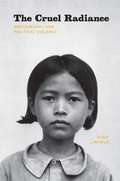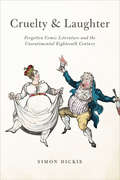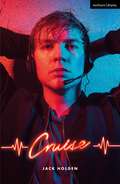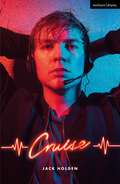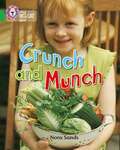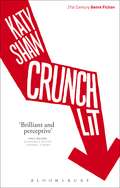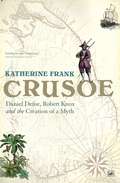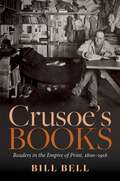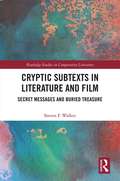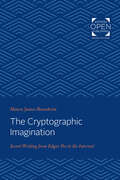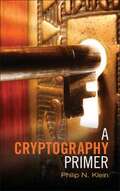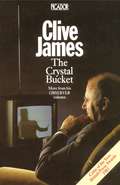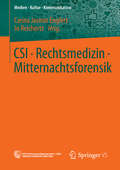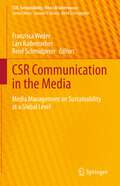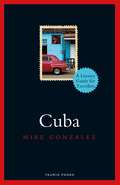- Table View
- List View
The Cruel Radiance: Photography and Political Violence
by Susie LinfieldIn The Cruel Radiance, Susie Linfield challenges the idea that photographs of political violence exploit their subjects and pander to the voyeuristic tendencies of their viewers. Instead she argues passionately that looking at such images—and learning to see the people in them—is an ethically and politically necessary act that connects us to our modern history of violence and probes the human capacity for cruelty. Grappling with critics from Walter Benjamin and Bertolt Brecht to Susan Sontag and the postmoderns—and analyzing photographs from such events as the Holocaust, China’s Cultural Revolution, and recent terrorist acts—Linfield explores the complex connection between photojournalism and the rise of human rights ideals. In the book’s concluding section, she examines the indispensable work of Robert Capa, James Nachtwey, and Gilles Peress and asks how photography should respond to the increasingly nihilistic trajectory of modern warfare. A bracing and unsettling book, The Cruel Radiance convincingly demonstrates that if we hope to alleviate political violence, we must first truly understand it—and to do that, we must begin to look.
The Cruel Radiance: Photography and Political Violence
by Susie LinfieldIn The Cruel Radiance, Susie Linfield challenges the idea that photographs of political violence exploit their subjects and pander to the voyeuristic tendencies of their viewers. Instead she argues passionately that looking at such images—and learning to see the people in them—is an ethically and politically necessary act that connects us to our modern history of violence and probes the human capacity for cruelty. Grappling with critics from Walter Benjamin and Bertolt Brecht to Susan Sontag and the postmoderns—and analyzing photographs from such events as the Holocaust, China’s Cultural Revolution, and recent terrorist acts—Linfield explores the complex connection between photojournalism and the rise of human rights ideals. In the book’s concluding section, she examines the indispensable work of Robert Capa, James Nachtwey, and Gilles Peress and asks how photography should respond to the increasingly nihilistic trajectory of modern warfare. A bracing and unsettling book, The Cruel Radiance convincingly demonstrates that if we hope to alleviate political violence, we must first truly understand it—and to do that, we must begin to look.
Cruelty and Laughter: Forgotten Comic Literature and the Unsentimental Eighteenth Century
by Simon DickieEighteenth-century British culture is often seen as polite and sentimental—the creation of an emerging middle class. Simon Dickie disputes these assumptions in Cruelty and Laughter, a wildly enjoyable but shocking plunge into the forgotten comic literature of the age. Beneath the surface of Enlightenment civility, Dickie uncovers a rich vein of cruel humor that forces us to recognize just how slowly ordinary human sufferings became worthy of sympathy. Delving into an enormous archive of comic novels, jestbooks, farces, variety shows, and cartoons, Dickie finds a vast repository of jokes about cripples, blind men, rape, and wife-beating. Epigrams about syphilis and scurvy sit alongside one-act comedies about hunchbacks in love. He shows us that everyone—rich and poor, women as well as men—laughed along. In the process, Dickie also expands our understanding of many of the century’s major authors, including Samuel Richardson, Lady Mary Wortley Montagu, Tobias Smollett, Frances Burney, and Jane Austen. He devotes particular attention to Henry Fielding’s Joseph Andrews, a novel that reflects repeatedly on the limits of compassion and the ethical problems of laughter. Cruelty and Laughter is an engaging, far-reaching study of the other side of culture in eighteenth-century Britain.
Cruelty and Laughter: Forgotten Comic Literature and the Unsentimental Eighteenth Century
by Simon DickieEighteenth-century British culture is often seen as polite and sentimental—the creation of an emerging middle class. Simon Dickie disputes these assumptions in Cruelty and Laughter, a wildly enjoyable but shocking plunge into the forgotten comic literature of the age. Beneath the surface of Enlightenment civility, Dickie uncovers a rich vein of cruel humor that forces us to recognize just how slowly ordinary human sufferings became worthy of sympathy. Delving into an enormous archive of comic novels, jestbooks, farces, variety shows, and cartoons, Dickie finds a vast repository of jokes about cripples, blind men, rape, and wife-beating. Epigrams about syphilis and scurvy sit alongside one-act comedies about hunchbacks in love. He shows us that everyone—rich and poor, women as well as men—laughed along. In the process, Dickie also expands our understanding of many of the century’s major authors, including Samuel Richardson, Lady Mary Wortley Montagu, Tobias Smollett, Frances Burney, and Jane Austen. He devotes particular attention to Henry Fielding’s Joseph Andrews, a novel that reflects repeatedly on the limits of compassion and the ethical problems of laughter. Cruelty and Laughter is an engaging, far-reaching study of the other side of culture in eighteenth-century Britain.
Cruelty and Laughter: Forgotten Comic Literature and the Unsentimental Eighteenth Century
by Simon DickieEighteenth-century British culture is often seen as polite and sentimental—the creation of an emerging middle class. Simon Dickie disputes these assumptions in Cruelty and Laughter, a wildly enjoyable but shocking plunge into the forgotten comic literature of the age. Beneath the surface of Enlightenment civility, Dickie uncovers a rich vein of cruel humor that forces us to recognize just how slowly ordinary human sufferings became worthy of sympathy. Delving into an enormous archive of comic novels, jestbooks, farces, variety shows, and cartoons, Dickie finds a vast repository of jokes about cripples, blind men, rape, and wife-beating. Epigrams about syphilis and scurvy sit alongside one-act comedies about hunchbacks in love. He shows us that everyone—rich and poor, women as well as men—laughed along. In the process, Dickie also expands our understanding of many of the century’s major authors, including Samuel Richardson, Lady Mary Wortley Montagu, Tobias Smollett, Frances Burney, and Jane Austen. He devotes particular attention to Henry Fielding’s Joseph Andrews, a novel that reflects repeatedly on the limits of compassion and the ethical problems of laughter. Cruelty and Laughter is an engaging, far-reaching study of the other side of culture in eighteenth-century Britain.
Cruelty and Laughter: Forgotten Comic Literature and the Unsentimental Eighteenth Century
by Simon DickieEighteenth-century British culture is often seen as polite and sentimental—the creation of an emerging middle class. Simon Dickie disputes these assumptions in Cruelty and Laughter, a wildly enjoyable but shocking plunge into the forgotten comic literature of the age. Beneath the surface of Enlightenment civility, Dickie uncovers a rich vein of cruel humor that forces us to recognize just how slowly ordinary human sufferings became worthy of sympathy. Delving into an enormous archive of comic novels, jestbooks, farces, variety shows, and cartoons, Dickie finds a vast repository of jokes about cripples, blind men, rape, and wife-beating. Epigrams about syphilis and scurvy sit alongside one-act comedies about hunchbacks in love. He shows us that everyone—rich and poor, women as well as men—laughed along. In the process, Dickie also expands our understanding of many of the century’s major authors, including Samuel Richardson, Lady Mary Wortley Montagu, Tobias Smollett, Frances Burney, and Jane Austen. He devotes particular attention to Henry Fielding’s Joseph Andrews, a novel that reflects repeatedly on the limits of compassion and the ethical problems of laughter. Cruelty and Laughter is an engaging, far-reaching study of the other side of culture in eighteenth-century Britain.
Cruelty and Laughter: Forgotten Comic Literature and the Unsentimental Eighteenth Century
by Simon DickieEighteenth-century British culture is often seen as polite and sentimental—the creation of an emerging middle class. Simon Dickie disputes these assumptions in Cruelty and Laughter, a wildly enjoyable but shocking plunge into the forgotten comic literature of the age. Beneath the surface of Enlightenment civility, Dickie uncovers a rich vein of cruel humor that forces us to recognize just how slowly ordinary human sufferings became worthy of sympathy. Delving into an enormous archive of comic novels, jestbooks, farces, variety shows, and cartoons, Dickie finds a vast repository of jokes about cripples, blind men, rape, and wife-beating. Epigrams about syphilis and scurvy sit alongside one-act comedies about hunchbacks in love. He shows us that everyone—rich and poor, women as well as men—laughed along. In the process, Dickie also expands our understanding of many of the century’s major authors, including Samuel Richardson, Lady Mary Wortley Montagu, Tobias Smollett, Frances Burney, and Jane Austen. He devotes particular attention to Henry Fielding’s Joseph Andrews, a novel that reflects repeatedly on the limits of compassion and the ethical problems of laughter. Cruelty and Laughter is an engaging, far-reaching study of the other side of culture in eighteenth-century Britain.
Cruelty and Laughter: Forgotten Comic Literature and the Unsentimental Eighteenth Century
by Simon DickieEighteenth-century British culture is often seen as polite and sentimental—the creation of an emerging middle class. Simon Dickie disputes these assumptions in Cruelty and Laughter, a wildly enjoyable but shocking plunge into the forgotten comic literature of the age. Beneath the surface of Enlightenment civility, Dickie uncovers a rich vein of cruel humor that forces us to recognize just how slowly ordinary human sufferings became worthy of sympathy. Delving into an enormous archive of comic novels, jestbooks, farces, variety shows, and cartoons, Dickie finds a vast repository of jokes about cripples, blind men, rape, and wife-beating. Epigrams about syphilis and scurvy sit alongside one-act comedies about hunchbacks in love. He shows us that everyone—rich and poor, women as well as men—laughed along. In the process, Dickie also expands our understanding of many of the century’s major authors, including Samuel Richardson, Lady Mary Wortley Montagu, Tobias Smollett, Frances Burney, and Jane Austen. He devotes particular attention to Henry Fielding’s Joseph Andrews, a novel that reflects repeatedly on the limits of compassion and the ethical problems of laughter. Cruelty and Laughter is an engaging, far-reaching study of the other side of culture in eighteenth-century Britain.
Cruise (Modern Plays)
by Jack HoldenSet in London's Soho in the 1980s, Cruise tells the story of what should have been Michael Spencer's last night on Earth. Diagnosed with HIV in 1984, he's told by doctors that he has just four years to live, so as the clock runs down, Michael decides to go out in style. As he parties and bids final farewells to his friends, the clock strikes zero and Michael… survives. With the gift of life, how can he go on living?Jack Holden's debut play Cruise is a kaleidoscopic new monologue celebrating queer culture and paying tribute to ageneration of gay men lost to the AIDS crisis. This edition was published to coincide with its West End production in May 2021.
Cruise (Modern Plays)
by Jack HoldenSet in London's Soho in the 1980s, Cruise tells the story of what should have been Michael Spencer's last night on Earth. Diagnosed with HIV in 1984, he's told by doctors that he has just four years to live, so as the clock runs down, Michael decides to go out in style. As he parties and bids final farewells to his friends, the clock strikes zero and Michael… survives. With the gift of life, how can he go on living?Jack Holden's debut play Cruise is a kaleidoscopic new monologue celebrating queer culture and paying tribute to ageneration of gay men lost to the AIDS crisis. This edition was published to coincide with its West End production in May 2021.
Crunch And Munch: Band 05/green (Collins Big Cat Ser.)
by Nora Sands Cliff Moon Collins Big CatFrom Jamie Oliver's favourite dinner lady, Nora Sands, this recipe book is all you need to make some great healthy meals that are fun too. Each recipe includes an ingredients list, a child-friendly method and a 'Top Tip'. There is a contents page on page 1, plus a glossary and index on pages 20 and 21. This is a Band 05/Green book in the Collins Big Cat reading programme which offers early readers patterned language and varied characters. This is an instruction text with a café menu on page 22 and opening hours on page 23 which encourage children to discuss recipes and healthy food they enjoy and would like in their own café. This story supports science learning about life processes and living things, as well as humans and other animals. It also promotes knowledge that eating the right types of food help keep humans healthy. This book has been levelled for Reading Recovery. For more guided reading books in this Collins Big Cat band, try The Magic Pen (9780007185887) written by Hiawyn Oran and illustrated by Nick Schon.
Crunch Lit (21st Century Genre Fiction)
by Katy ShawThe financial crisis of 2008 quickly gave rise to a growing body of fiction: "crunch lit". Populated by a host of unsympathetic characters and centred around banking institutions, these 'recession writings' take the financial crisis as their central narrative concern to produce a new wave of literary and popular writings that satirise the origins and effects of modern life, consumer culture and the credit boom. Examining a range of texts from such writers as John Lanchester, Jonathan Franzen, Don DeLillo, Sebastian Faulks and Bret Easton Ellis, this book offers the first wide-ranging guide to this new genre. Exploring the key themes of the genre and its antecedents in fictional representations of finance by the likes of Dickens, Conrad, Zola and Trollope, Crunch Lit also includes a timeline of key historical events, guides to further and online resources and biographies of key authors. Supported by online resources, the book is an essential read for students of 21st century literature and culture.
Crunch Lit (21st Century Genre Fiction)
by Katy ShawThe financial crisis of 2008 quickly gave rise to a growing body of fiction: "crunch lit". Populated by a host of unsympathetic characters and centred around banking institutions, these 'recession writings' take the financial crisis as their central narrative concern to produce a new wave of literary and popular writings that satirise the origins and effects of modern life, consumer culture and the credit boom. Examining a range of texts from such writers as John Lanchester, Jonathan Franzen, Don DeLillo, Sebastian Faulks and Bret Easton Ellis, this book offers the first wide-ranging guide to this new genre. Exploring the key themes of the genre and its antecedents in fictional representations of finance by the likes of Dickens, Conrad, Zola and Trollope, Crunch Lit also includes a timeline of key historical events, guides to further and online resources and biographies of key authors. Supported by online resources, the book is an essential read for students of 21st century literature and culture.
Crusoe: Daniel Defoe, Robert Knox And The Creation Of A Myth
by Katherine FrankIt is January 1719 and Daniel Defoe, almost sixty, sits at a table, writing. He is troubled with gout and debt, but for now is preoccupied with a younger man on a barren shore – Robinson Crusoe, for which he will principally be remembered.Several miles south, an old man, Robert Knox, is bent over a heavy volume. It is Historical Relation, his account of being held captive on Ceylon, published forty years ago after he escaped and returned to England. It has long been out of print, but a copy perhaps sits on the desk of Daniel Defoe as he writes.Where did Crusoe come from? And what is the secret of his endurance? Crusoe explores the intertwined lives of two real men – Daniel Defoe and Robert Knox – and the character and book that emerged from their peculiar conjunction. It is the biography of a book and its hero, the story of Defoe, the man who wrote Robinson Crusoe, and of Robert Knox, the man who was Crusoe.
Crusoe's Books: Readers in the Empire of Print, 1800-1918
by Bill BellThis is a book about readers on the move in the age of Victorian empire. It examines the libraries and reading habits of five reading constituencies from the long nineteenth century: shipboard emigrants, Australian convicts, Scottish settlers, polar explorers, and troops in the First World War. What was the role of reading in extreme circumstances? How were new meanings made under strange skies? How was reading connected with mobile communities in an age of expansion? Uncovering a vast range of sources from the period, from diaries, periodicals, and literary culture, Bill Bell reveals some remarkable and unanticipated insights into the way that reading operated within and upon the British Empire for over a century.
Crusoe's Books: Readers in the Empire of Print, 1800-1918
by Bill BellThis is a book about readers on the move in the age of Victorian empire. It examines the libraries and reading habits of five reading constituencies from the long nineteenth century: shipboard emigrants, Australian convicts, Scottish settlers, polar explorers, and troops in the First World War. What was the role of reading in extreme circumstances? How were new meanings made under strange skies? How was reading connected with mobile communities in an age of expansion? Uncovering a vast range of sources from the period, from diaries, periodicals, and literary culture, Bill Bell reveals some remarkable and unanticipated insights into the way that reading operated within and upon the British Empire for over a century.
Cryptic Subtexts in Literature and Film: Secret Messages and Buried Treasure
by Steven F WalkerOne of the primary objectives of comparative literature is the study of the relationship of texts, also known as intertextuality, which is a means of contextualizing and analyzing the way literature grows and flourishes through inspiration and imitation, direct or indirect. When the inspiration and imitation is direct and obvious, the study of this rapport falls into the more restricted category of hypertextuality. What the author has labeled a cryptic subtext, however, is an extreme case of hypertextuality. It involves a series of allusions to another text that have been deliberately inserted by the author into the primary text as potential points of reference. This book takes a deep dive into a broad array of literature and film to explore these allusions and the hidden messages therein.
Cryptic Subtexts in Literature and Film: Secret Messages and Buried Treasure
by Steven F WalkerOne of the primary objectives of comparative literature is the study of the relationship of texts, also known as intertextuality, which is a means of contextualizing and analyzing the way literature grows and flourishes through inspiration and imitation, direct or indirect. When the inspiration and imitation is direct and obvious, the study of this rapport falls into the more restricted category of hypertextuality. What the author has labeled a cryptic subtext, however, is an extreme case of hypertextuality. It involves a series of allusions to another text that have been deliberately inserted by the author into the primary text as potential points of reference. This book takes a deep dive into a broad array of literature and film to explore these allusions and the hidden messages therein.
The Cryptographic Imagination: Secret Writing from Edgar Poe to the Internet (Parallax: Re-visions of Culture and Society)
by Shawn James RosenheimOriginally published in 1996. In The Cryptographic Imagination, Shawn Rosenheim uses the writings of Edgar Allan Poe to pose a set of questions pertaining to literary genre, cultural modernity, and technology. Rosenheim argues that Poe's cryptographic writing—his essays on cryptography and the short stories that grew out of them—requires that we rethink the relation of poststructural criticism to Poe's texts and, more generally, reconsider the relation of literature to communication. Cryptography serves not only as a template for the language, character, and themes of much of Poe's late fiction (including his creation, the detective story) but also as a "secret history" of literary modernity itself. "Both postwar fiction and literary criticism," the author writes, "are deeply indebted to the rise of cryptography in World War II." Still more surprising, in Rosenheim's view, Poe is not merely a source for such literary instances of cryptography as the codes in Conan Doyle's "The Dancing-Men" or in Jules Verne, but, through his effect on real cryptographers, Poe's writing influenced the outcome of World War II and the development of the Cold War. However unlikely such ideas sound, The Cryptographic Imagination offers compelling evidence that Poe's cryptographic writing clarifies one important avenue by which the twentieth century called itself into being. "The strength of Rosenheim's work extends to a revisionistic understanding of the entirety of literary history (as a repression of cryptography) and then, in a breathtaking shift of register, interlinks Poe's exercises in cryptography with the hyperreality of the CIA, the Cold War, and the Internet. What enables this extensive range of applications is the stipulated tension Rosenheim discerns in the relationship between the forms of the literary imagination and the condition of its mode of production. Cryptography, in this account, names the technology of literary production—the diacritical relationship between decoding and encoding—that the literary imagination dissimulates as hieroglyphics—the hermeneutic relationship between a sign and its content."—Donald E. Pease, Dartmouth College
The Crystal Bucket: Television Criticism From The Observer, 1976-79 (Picador Bks.)
by Clive JamesThe second instalment in Clive James’s TV criticism collection – The Crystal Bucket - earned him the title ‘Critic of the Year’ by the British Press Awards. Taking its title from Walter Raleigh’s The Passionate Man’s Pilgrimage and is dedicated to the poet Peter Porter.
CSI • Rechtsmedizin • Mitternachtsforensik (Medien • Kultur • Kommunikation)
by Carina Jasmin Englert Jo ReichertzDas Buch gibt einen Einblick in die Entwicklung eines Marktes in undum die deutsche Rechtsmedizin. Seit die Aufmerksamkeit der Medieneine Währung ist, konkurrieren auf diesem Markt unterschiedlicheAkteure miteinander. Diese Entwicklung geht auf Fernsehsendungen überVerbrechensaufklärung und Rechtsmedizin zurück und umfasst mehr alsden im US-amerikanischen Diskurs postulierten CSI-Effekt. Diesererklärt den Zusammenhang zwischen Fernsehsendungen wie _CSI: LasVegas_ und dem Verhalten von Geschworenen vor Gericht und demInteresse der Öffentlichkeit an Gerichtsmedizin. Dabei gerät aus demBlick, dass die Sendungen in ihren Darstellungen über die Wirkmachtrechtsmedizinischer Methoden nicht nur sehr unterschiedlich ausfallenkönnen, sondern dass auch die Folgen dieser medialen Darstellungenvielfältige gesellschaftliche Entwicklungen anstoßen.
CSR Communication in the Media: Media Management on Sustainability at a Global Level (CSR, Sustainability, Ethics & Governance)
by Franzisca Weder Lars Rademacher René SchmidpeterCorporate social responsibility (CSR) is an established management focus of today's companies and organizations of different types, scope and size. Communication practices on CSR and sustainability in the media industry, related theoretical concepts, and empirical foundations have not yet been sufficiently explored. This book focuses on a new normative framework of sustainability, bridging the established debate on public value with the current debate on social impact and the social license to operate in the media industry. With a variety of contributions from theory and practice, the book addresses the dual nature of media and media companies, which simultaneously produce economic and cultural goods and thus bear a "double responsibility": on the one hand, for the way they present reality, monitor and criticize economic and political developments, and bring ethical concerns to the public debate. On the other hand, they bear responsibility for their own activities as companies (license to operate). The book is therefore aimed at readers interested in the journalistic perspective and at executives in the media industry.
Cuba (Literary Guides for Travellers)
by Mike GonzalezCuba with its flamboyant style and rich culture, has provided the inspiration and setting for literature for decades. It has always been one of the most compelling places in the world, though perhaps never more so than now. Following Raúl Castro's resignation as President in 2018, the era of Castroism has come to an end, and the US-Cuba rapprochement has opened the country to a generation of Americans whose only previous exposure was through film and literature. The coming years will undoubtedly bring significant changes to a country that has in many ways been frozen in time.Cuba: A Literary Guide for Travellers takes the literary-minded traveller (either in person or in an armchair) on a vivid and illuminating journey, retracing the footsteps of writers and artists who have lived and worked in, or been inspired by, the history and landscape of Cuba. This literary guide challenges some firmly-held Western assumptions about the country, and shines a light on one of the richest and most deeply embedded literary cultures in the world.
Cuba (Literary Guides for Travellers)
by Mike GonzalezCuba has always been one of the most compelling places in the world, but perhaps never more so than now. With Raoul's promise to resign in 2018, the era of Castroism is all but over and the 2014 US-Cuba rapprochement has opened the country up for the first time to a generation of Americans whose only previous way in was through film and literature. The coming years will undoubtedly bring significant changes to a country that has in many ways been frozen in time. There is no better time for a Cuba literary guide, which challenges some firmly-held western assumptions about the country and shines a light on one of the richest and most deeply embedded literary cultures in the world. Cuba: A Literary Guide for Travellers takes the reader on a dynamic journey into the imaginations of iconic writers and artists in the heart of one of the most alluring countries in the world.
